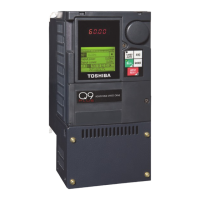Alarms, Trips, and Troubleshooting
Q9 Plus ASD Install/Op Manual
272 https://www.toshiba.com/tic/
Trip History
The Trip History screen records the system
parameters for up to 20 trips. The recorded trips are
numbered from zero to 19. Once the Trip History
record reaches trip number 19, the oldest recorded
trip will be deleted with each new record stored
(first-in first-out). The Trip # field may be selected
and scrolled through to view the recorded trip
information for a given trip number. The monitored
parameters are listed in Table as At-trip Recorded
Parameters (parameter readings at the time that the
trip occurred).
Clearing a Trip
Once the cause of the trip has been corrected,
performing a Reset re-enables the Q9 Plus ASD for
normal operation.
The record of a trip may also be cleared using one
of the following methods:
• Cycling power (trip info may be saved via F602 if
desired),
• Pressing the Stop-Reset key twice,
• Remotely via the communications channel,
• Momentarily connecting terminal RES to CC of
the Terminal Board, or
• Via Program Utilities Type Reset: Clear
Past Trip (clears Monitor screen records only).
Table 19. Trip History Record Parameters.
At-trip Recorded Parameters
1) Trip Number 8) Frequency Reference 15) Feedback (1 sec.) 22) ASD Overload
2) Trip Type 9) Bus Voltage 16) Torque 23) DBR Overload
3) Time and Date 10) Discrete Input Status 17) Torque Reference 24) Motor Load
4) Frequency at Trip 11) OUT1/OUT2/FL Status 18) Torque Current 25) ASD Load
5) Output Current 12) Timer 19) Excitation Current 26) DBR Load
6) Output Voltage 13) Post Compensation Frequency 20) PID Value 27) Input Power
7) Direction 14) Feedback (inst.) 21) Motor Overload 28) Output Power
Note: Trip records are comprised of the full list of monitored parameters (28).

